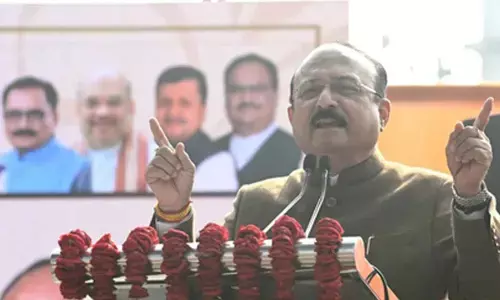Stay invested in stock mkts despite current volatility

In a recent event, I attended conducted by a financial services group, they were surprised to hear that our clients are fine with the current downside market volatility as weve good amount of cash generated from the earlier profit booking to invest for and see this as an opportunity What Ive realized is that its not just market volatility but the overdose of stories that do rounds in these t
In a recent event, I attended conducted by a financial services group, they were surprised to hear that our clients are fine with the current downside market volatility as we’ve good amount of cash (generated from the earlier profit booking) to invest for and see this as an opportunity. What I’ve realized is that it’s not just market volatility but the overdose of stories that do rounds in these times is what makes investing difficult. True, there is lurking danger of losing money when investing in equities but that’s the part of the risk one is willing to or should be willing to take.
And I’ve seen people not countering their fears properly while investing. As Jason Zweig said, “investors always have a plan until the market punches them in the face”. Exactly! Right in the face is when people get not just startled but scared and act incoherently. This is the moment which decides whether your fears turn losses or not. As we wind up the year, except for the NSE IT which has returned about 25 per cent in the last calendar year, none others even added much. A bit by the bank index adding 5 per cent which improved the overall larger indices of NIFTY 50 and 100 turn green with 3 per cent and 1 per cent respectively. Most of the other indices have gone red with other major indices of Midcap and NSE 500 at negative 41 per cent and negative 29 per cent respectively.
These numbers are on a horror scale even for a seasoned investor. These kind of market situations induce immense fear in us and our brains extrapolate the situation to the logical worst scenario creating for more fear. Dan Gardner narrated in “The Science of Fear” where he recounted that post 9/11, in the US, there was a huge reduction in air travel and coincidentally increased the road trips. However, if a 9/11 impact attack had happened every single day for a year, the odds that you’d be killed by such an attack would be one in 7,750, still greater that the actual odds of dying in a traffic accident, which are one in 6,498. One estimate puts that the increase in automobile travel in that year post-9/11 resulted in 1,595 more traffic fatalities than would have otherwise occurred.
Markets are inundated by various kinds of investors, each looking to make money at their own timelines and hence we see the market moving up and down. Each group of investors try to exploit the opportunities to generate profits within their own timeframe which creates these puddles of risk or opportunity depending upon how one looks at it. Now, bring in the emotions of the investors from their investing perspective and that charts out how the market operates. If 2017 was a year where even random portfolios have generated double digit returns, this year has tested each of the investors both retail and institutional alike. As Morgan Housel famously put, “every past decline looks like an opportunity, every future decline looks like a risk.”
Of course, it’s also to do with what has the experience from the past has taught us. If we’d experienced pain during a fall and balled out completely, it’s very difficult to take part in the next rally as we turn averse to it. So, the key is to stay in the market so that one could witness what translates post a fall. I’m not recommending a particular way to react or respond to the current market conditions, but it certainly brings out particular emotions and habits out as an investor. It’s important for us to list them and elaborate the feelings associated with it which would be our own way of scripting a lesson to be read at a later day in future.
These are also the times to not just reflect and ponder but shape or change financial habits. When the going is tough, you need to turn tougher making us to look at our finances, budgets and spending ways thus altering for better. These times also bring out humility from us. The cracking markets bring out modesty in our hearts and to our lives. As Buffet says, “be fearful when others are greedy and be greedy when others are fearful.” The widespread fear is your friend as it serves bargain purchases while personal fear is your enemy.
It makes no sense to check your portfolio on a daily basis especially when you’re invested appropriately for your goals. We can’t rejig and realign for all the market changes each time which are completely out of our control and should concentrate on things we have control on i.e., risk appetite, expenses and most importantly emotions. Wishing you all a happy new year and hopefully a better investing experience into the coming year.
(The author is a co-founder of ‘Wealocity’, a wealth management firm and could be reached at [email protected])














